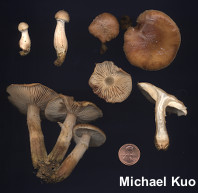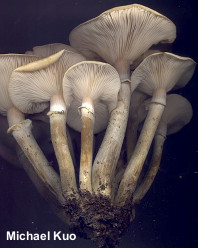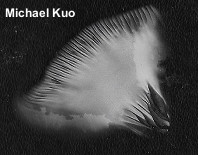| Major Groups > Gilled Mushrooms > Pale-Spored > Armillaria |

|
The Genus Armillaria [ Basidiomycota > Agaricales > Physalaciaceae . . . ] by Michael Kuo The genus Armillaria contains wood-rotting gilled mushrooms with white spore prints and gills that are attached to the stem or run down it. Most of the species have a partial veil, but the veil can manifest in several different forms—from cob-webby ring zones to full-blown rings. Roughly a dozen species occur in North America. Many of these are parasitic, and many form visible black rhizomorphs in the wood; others are apparently benign saprobes and do not form conspicuous rhizomorphs. The species in Armillaria are well-studied and supported by all four "legs" of the species definition stool: ecological, morphological, biological, and phylogenetic separation. In other words, DNA studies, mating studies, and traditional morphology (in most cases) agree on the species, which are also limited to specific environmental niches. This kind of species-concept confluence is not the norm in mycology, so enjoy this genus if you are someone who dislikes confusion! Identification of Armillaria species can often be accomplished with close attention to physical features and collection location. However, a few species pairs, in limited geographic areas where they overlap, are morphologically "cryptic" and can only reliably be separated with mating or DNA study (see the key below). Microscopic examination is generally not useful in North American Armillaria identification; differences in spore size, cheilocystidia, and pileipellis are not significant between |
|
|
Key to 9 Species of Armillaria in North America
References Anderson, J. B. & R. C. Ulrich (1979). Biological species of Armillaria mellea in North America. Mycologia 71: 402–412. Anderson, J. B. (1986). Biological species of Armillaria in North America: Redesignation of groups IV and VIII and enumeration of voucher strains for other groups. Mycologia 78: 837–839. Banik, M. T., J. A. Paul & H. H. Burdsall (1995). Identification of Armillaria species from Wisconsin and adjacent areas. Mycologia 87: 707–712. Banik, M. T., T. J. Volk & H. H. Burdsall (1996). Armillaria species of the Olympic Peninsula of Washington state, including confirmation of North American biological species XI. Mycologia 88: 492–496. Baumgartner, K. & Rizzo, D. M. (2001). Distribution of Armillaria species in California. Mycologia 93: 821–830. Berube, J. A. & M. Dessureault (1988). Morphological characterization of Armillaria ostoyae and Armillaria sinapina sp. nov. Canadian Journal of Botany 66: 2027–2034. Berube, J. A. & M. Dessureault (1989). Morphological studies of the Armillaria mellea complex: Two new species, A. gemina and A. calvescens. Mycologia 81: 216–225. Brazee, N. J. & R. L. Wick (2011). Armillaria species distribution and site relationships in Pinus- and Tsuga-dominated forests in Massachusetts. Canadian Journal of Forestry Research 41: 1477–1490. Brazee, N. J., B. Ortiz-Santana, M. T. Banik & D. L. Lindner (2012). Armillaria altimontana, a new species from the western interior of North America. Mycologia 104: 1200–1205. Burdsall, H. H. & T. J. Volk (2008). Armillaria solidipes, an older name for the fungus called Armillaria ostoyae. North American Fungi 3: 261–267. Caballero, J. R. I., B. M. Lalande, J. W. Hanna, N. B. Klopfenstein, M. -S. Kim & J. E. Stewart (2023). Genomic comparisons of two Armillaria species with different ecological behaviors and their associated soil microbial communities. Microbial Ecology 85: 708–729. Coetzee, M. P. A. et al. (2000). Geographical diversity of Armillaria mellea s. s. based on phylogenetic analysis. Mycologia 92: 105–113. Dettman, J. R. & Kamp, B. J. van der. (2001). The population structure of Armillaria ostoyae and Armillaria sinapina in the central interior of British Columbia. Canadian Journal of Botany 79: 600–611. Fox, R. T. V. & Sanson, S. (1996). Lethal effects of an electrical field on Armillaria mellea in culture. Mycological Research 100: 318–320. Hanna, J. W., N. B. Klopfenstein, M. -S. Kim, G. I. McDonald & J. A. Moore (2007). Phylogeographic patterns of Armillaria ostoyae in the western United States. Forest Pathology 37: 192–216. Kelley, M. B., M. K. Fierke & F. M. Steohen (2009). Identification and distribution of Armillaria species associated with an oak decline event in the Arkansas Ozarks. Forest Pathology 39: 397–404. Kim, M. -S., N. B. Klopfenstein, G. I. McDonald, K. Arumuganathan & A. K. Vidaver (2000). Characterization of North American Armillaria species by nuclear DNA content and RFLP analysis. Mycologia 92: 874–883. Kim, M. -S., N. B. Klopfenstein, J. W. Hanna & G. I. McDonald (2006). Characterization of North American Armillaria species: genetic relationships determined by ribosomal DNA sequences and AFLP markers. Forest Pathology 36: 145–164. Kim, M. -S. & N. B. Klopfenstein (2011). Molecular identification of Armillaria gallica from the Niobrara Valley Preserve in Nebraska. Journal of Phytopathology 159: 69–71. Kim, M. -S., R. A. Blaedow, K. M. McKeever, R. O. Olatinwo & N. B. Klopfenstein (2023). First report of the Armillaria root disease pathogen, Armillaria solidipes, on black oak (Quercus velutina) in North Carolina, U. S. A. Plant Disease 107: 2261. Klopfenstein, N. B. & 29 coauthors (2017). Insights into the phylogeny of Northern Hemisphere Armillaria: Neighbor-net and Bayesian analyses of translation elongation factor 1-α gene sequences. Mycologia 109: 75–91. Ross-Davis, A. L., J. W. Hanna, M. -S. Kim & N. B. Klopfenstein (2012). Advances toward DNA-based identification and phylogeny of North American Armillaria species using elongation factor-1 alpha gene. Mycoscience 53: 161–165. Sahu, N. & 33 coauthors (2023). Vertical and horizontal gene transfer shaped plant colonization and biomass degradation in the fungal genus Armillaria. Nature Microbiology 8: 1668–1681. Termorshuizen, A. J. (1995). Armillaria (Fr.:Fr.) Staude. In Bas, C., Th. W. Kuyper, M. E. Noordeloos & E. C. Vellinga, Eds. Flora Agaricina Neerlandica: Critical monographs on families of agarics and boleti occurring in the Netherlands. Volume 3. Rotterdam: A. A. Balkema. 34–39. Thiers, H. D. & Sundberg, W. J. (1976). Armillaria (Tricholomataceae, Agaricales) in the western United States including a new species from California. Madroño 23: 448–453. Tsykun, T., D. Rigling & S. Prospero (2013). A new multilocus approach for a reliable DNA-based identification of Armillaria species. Mycologia 105: 1059–1076. Vesterholt, J. (2018). Armillaria. In Knudsen, H. & J. Vesterholt, eds. Funga Nordica: Agaricoid, boletoid and cyphelloid genera. Copenhagen: Nordsvamp. 252–254. Volk, T. J. & Burdsall, H. H. (1993). The state of taxonomy in the genus Armillaria. McIlvainea 11: 4–11. Volk, T. J. and H. H. Burdsall, Jr. (1995). A nomenclatural study of Armillaria and Armillariella species. Synopsis Fungorum 8. Fungiflora: Oslo, Norway. 121 pp. Volk, T. J., Burdsall, H. H. & Banik, M. T. (1996). Armillaria nabsnona, a new species from western North America. Mycologia 88: 484–491. Volk, T. J. (2005). Key to North American Armillaria species. Retrieved May 18, 2017 from the Tom Volk's Fungi Web site: http://botit.botany.wisc.edu/toms_fungi/armkey.html This site contains no information about the edibility or toxicity of mushrooms. Cite this page as: Kuo, M. (2017, September). The genus Armillaria. Retrieved from the MushroomExpert.Com Web site: http://www.mushroomexpert.com/armillaria.html © MushroomExpert.Com |


